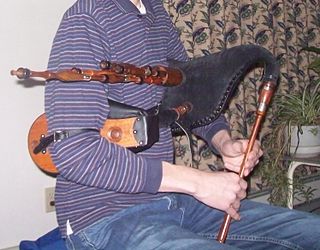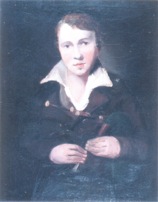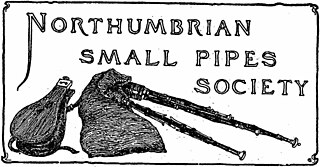
The Scottish smallpipe is a bellows-blown bagpipe re-developed by Colin Ross and many others, adapted from an earlier design of the instrument. There are surviving bellows-blown examples of similar historical instruments as well as the mouth-blown Montgomery smallpipes, dated 1757, which are held in the National Museum of Scotland. Some instruments are being built as direct copies of historical examples, but few modern instruments are directly modelled on older examples; the modern instrument is typically larger and lower-pitched. The innovations leading to the modern instrument, in particular the design of the reeds, were largely taken from the Northumbrian smallpipes.

The border pipes are a type of bagpipe related to the Scottish Great Highland Bagpipe. It is perhaps confusable with the Scottish smallpipe, although it is a quite different and much older instrument. Although most modern Border pipes are closely modelled on similar historic instruments, the modern Scottish smallpipes are a modern reinvention, inspired by historic instruments but largely based on Northumbrian smallpipes in their construction.

The Northumbrian smallpipes are bellows-blown bagpipes from North East England, where they have been an important factor in the local musical culture for more than 250 years. The family of the Duke of Northumberland have had an official piper for over 250 years. The Northumbrian Pipers' Society was founded in 1928, to encourage the playing of the instrument and its music; Although there were so few players at times during the last century that some feared the tradition would die out, there are many players and makers of the instrument nowadays, and the Society has played a large role in this revival. In more recent times the Mayor of Gateshead and the Lord Mayor of Newcastle have both established a tradition of appointing official Northumbrian pipers.
Here Northumbria is defined as Northumberland, the northernmost county of England, and County Durham. According to 'World Music: The Rough Guide', "nowhere is the English living tradition more in evidence than the border lands of Northumbria, the one part of England to rival the counties of the west of Ireland for a rich unbroken tradition. The region is particularly noted for its tradition of border ballads, the Northumbrian smallpipes and also a strong fiddle tradition in the region that was already well established in the 1690s. Northumbrian music is characterised by considerable influence from other regions, particularly southern Scotland and other parts of the north of England, as well as Irish immigrants.
The Northumbrian Pipers' Society was founded to promote both types of Northumbrian bagpipes – the Northumbrian smallpipes and the half-long pipes, now generally known as the Border pipes. There had been several attempts to encourage the pipes and their music during the 19th century, but no society was formed with this specific aim until the Northumbrian Small Pipes Society in 1893. That society organised a series of competitions, in which Richard Mowat and Henry Clough were both prizewinners. However it was short-lived, dissolving around 1899. Today the society is divided into two branches, the main branch based in Morpeth, and the Cleveland branch based in Sedgefield.
Tom Clough (1881–1964), known as "The Prince of Pipers", was an English player of the Northumbrian pipes, or Northumbrian smallpipes. He was also a pipemaker, and the pipes he made with Fred Picknell include several important innovations, and have a distinctive tone. He had studied the instrument with the noted piper Thomas Todd, and from his own father Henry Clough. His three surviving recordings, among the earliest recordings made of the instrument, and his considerable body of music manuscripts, including his own compositions, give considerable insight into the traditional playing technique and style of the instrument. This is particularly so because at least four previous generations of the family had been pipers, as was his son 'Young Tom' (1912–1987) – they thus form a continuous link between earliest players of the modern instrument, and contemporary players. In contrast to the widely accepted notion of traditional folk music as an essentially rural activity, he and his family lived in the mining community of Newsham in south-east Northumberland, and were miners themselves. At the end of his life, "Young Tom" recalled piping sessions at the 'Willow Tree' in Newsham, with his father Tom, grandfather Henry Clough, and Richard Mowat all playing – Henry's and Richard Mowat's playing would get more furious and inaccurate as the evening progressed; Tom was teetotal. Young Tom had the job of carrying his grandfather's pipes afterwards. There is a composite photograph of the Clough family at. Here Tom himself is on the left, his pipemaking collaborator Fred Picknell standing behind him, his father Henry Clough and son 'Young Tom' standing towards the right, while an older image of Tom's grandfather "Old Tom", seated piping in the foreground, has been added subsequently. Old Tom died in 1885, and the main photograph was taken in 1924. The other figure, seated on the far right, is believed to be Captain Nicholson of Haydon Bridge, a traditional fiddler.

The William Dixon manuscript, written down between 1733 and 1738 in Northumberland, is the oldest known manuscript of pipe music from the British Isles, and the most important source of music for the Border pipes. It is currently located in the A.K. Bell Library, Perth, Scotland. Little is known of William Dixon's biography, except what has been learned from this manuscript, and from parish records in Northumberland.
John Peacock was one of the finest Northumbrian smallpipers of his age, and probably a fiddler also, and the last of the Newcastle Waits. He studied the smallpipes with Old William Lamshaw, of Morpeth, and later with Joseph Turnbull, of Alnwick.
Robert Reid is widely acknowledged as the creator of the modern form of the Northumbrian Smallpipes. He lived and worked at first in Newcastle upon Tyne, but moved later to the nearby town of North Shields at the mouth of the Tyne, probably in 1802. North Shields was a busy port at this time. The Reids were a family with a long-standing connection to piping; Robert's father Robert Reed (sic), a cabinet maker, had been a player of the Northumbrian big-pipes, and an associate of James Allan, his son Robert was described later by James Fenwick as a beautiful player as well as maker of smallpipes, while Robert's son James (1814–1874) joined his father in the business. Robert died in North Shields on the 13th or 14 January 1837, and his death notice in the Newcastle Journal referred to him as a "piper, and as a maker of such instruments is known from the peer to the peasant, for the quality of their tone, and elegance of finish". He is buried in the graveyard of Christ Church, North Shields. His wife Isabella died in 1849, of cholera. There were repeated outbreaks of the disease at this time especially in the poor 'low town', near the river, where the Reids lived.
Colin Ross was an English folk musician who played fiddle and Northumbrian smallpipes. He was a noted maker of Northumbrian smallpipes, border pipes and Scottish smallpipes, and one of the inventors of the modern Scottish smallpipes.

Robert Elliot Bewick (1788–1849) was the son of the engraver Thomas Bewick. He was trained in engraving by his father, but is primarily remembered now as a player of the Northumbrian smallpipes.
Old Tom Clough, was an English player of the Northumbrian pipes, or Northumbrian smallpipes. He was born into a family of miners who had also been pipers for several generations; his son Henry, grandson Tom, and great-grandson 'Young' Tom were pipers too. He is thus a central figure in a family tradition linking the earliest days of the modern instrument to almost the present day.
Thomas Hair was a violinist and player of the Northumbrian smallpipes, who lived in Bedlington. This town, and the surrounding district of Bedlingtonshire, were until 1844 a detached part of County Durham, but were then made part of Northumberland.
William Green (1775–1860) was a player of the Northumbrian smallpipes, and the Piper to the Duchess of Northumberland from 1806 until 1849. He was assisted in this role by his nephew Robert Nicholson (1798–1842), and his son William Thomas (Tom) Green (1823–1898). Tom then succeeded his father as Ducal Piper until 1892. Father, nephew and son thus held some of the most influential piping roles in the county for a period of almost ninety years.

The Northumbrian Small Pipes Society was founded in 1893, by members of the Society of Antiquaries of Newcastle upon Tyne to promote interest in, and playing of Northumbrian smallpipes, and their music. As it only continued in existence for seven years, it is now regarded primarily as a short-lived precursor to the Northumbrian Pipers' Society. However, despite its short life, it played a significant role, publishing the first tutor for the instrument, J. W. Fenwick's Instruction Book for the Northumbrian Small-Pipes (1896), holding regular meetings, and organising annual competitions. In 1894 and 1896-7, the society published Transactions, as well as publishing an account of their Annual Meeting of 1897. As well as Members, who paid an annual 5s. subscription, there was a category of Honorary Playing Members. Since the society's records include the names and addresses of all members, of either kind, they have listed the names and addresses for 37 known pipers. Two articles in the Newcastle Courant, in April 1900, gave an account of their Annual General Meeting, at the Literary and Philosophical Society, and referred to the society as flourishing, with 200 members, of whom almost half were pipers. Officers were elected for the following year; however there is no subsequent record of any formal activity of the society, such as meetings or competitions. In 1906, when the Cloughs played for King Edward VII at Alnwick Castle, an account of this in the Berwickshire News stated that the Northumbrian Small Pipes Society had done some good work in reviving interest, but that 'seven winters had passed without it giving any signs of life'. This suggests that the society had been largely inactive for some time before its final AGM.
'Young' William Lamshaw was a player of the Northumbrian Smallpipes. Despite his early death, he was a significant figure in the history of the instrument, being appointed Piper to the Duchess of Northumberland at an early age, after the death of his grandfather Old William Lamshaw. He was active at a time when keys were being added to the instrument, and one of the most prominent early players of the improved instrument. Living in North Shields, it is very likely that he would have known Robert Reid, who had settled in the town in about 1802.
"Old" William Lamshaw, (c.1712-1798), was one of the earliest players of the Northumbrian Smallpipes of whom much is known. Besides being a celebrated piper in his own right, appointed to the post of piper to the Duchess of Northumberland after the death of Joseph Turnbull in 1775, he was the teacher of several other known pipers, and the grandfather of Young William Lamshaw, who succeeded him as piper to the Duchess.
William Cant (1753–1821) was a Northumbrian piper and violinist in the early part of the 19th century.
The Rook manuscript, a music manuscript compiled by John Rook, of Waverton, Cumbria in 1840, is "A Collection of English, Scotch, Irish and Welsh tunes, containing upwards of 1260 airs". These include many tunes, or versions of tunes, not found elsewhere. It is a particularly valuable resource for the study of the traditional music of Northern England, and specifically of music for the Northumbrian Smallpipes.
Cornelius Stanton was a mid-19th-century Northumbrian piper.





